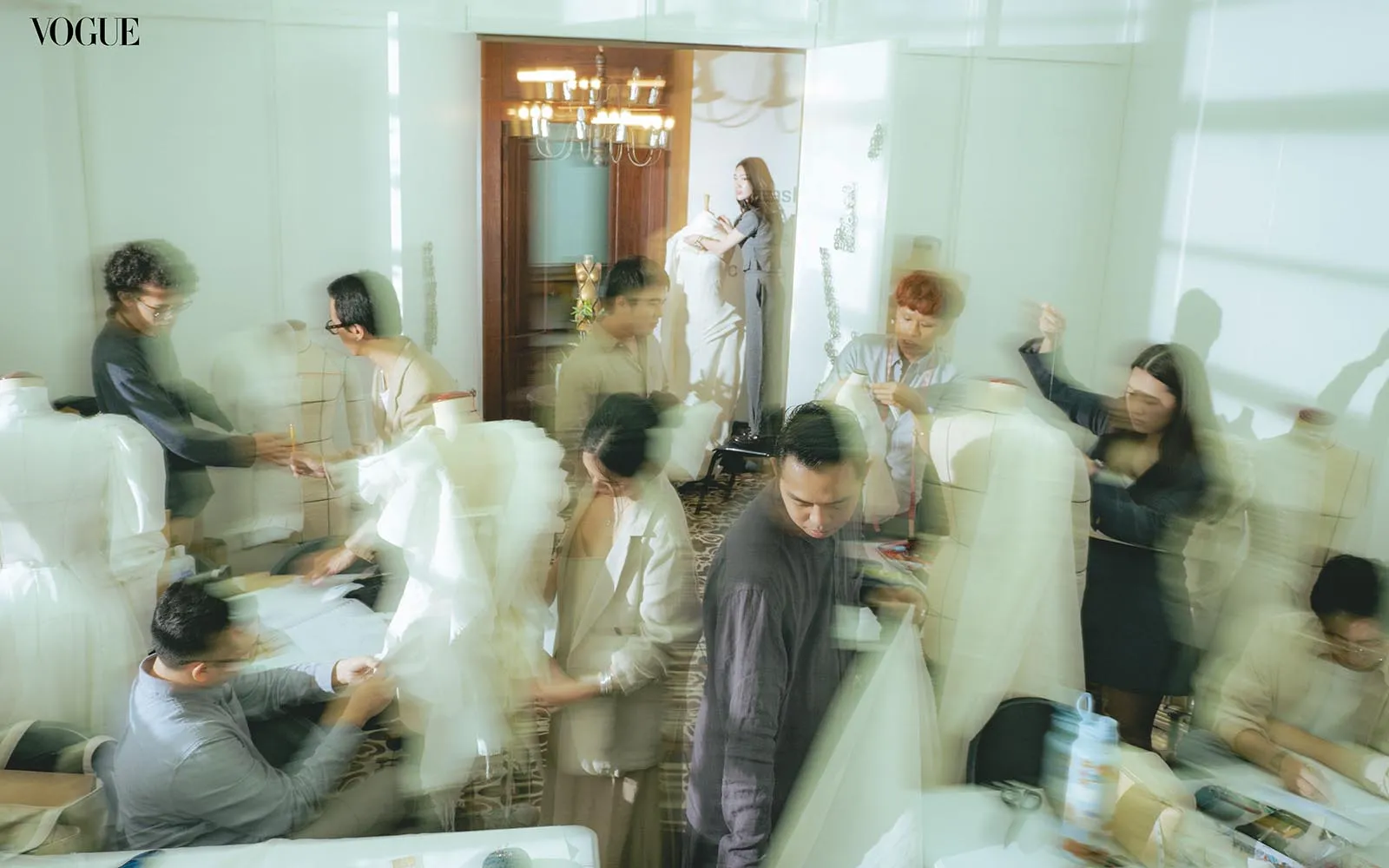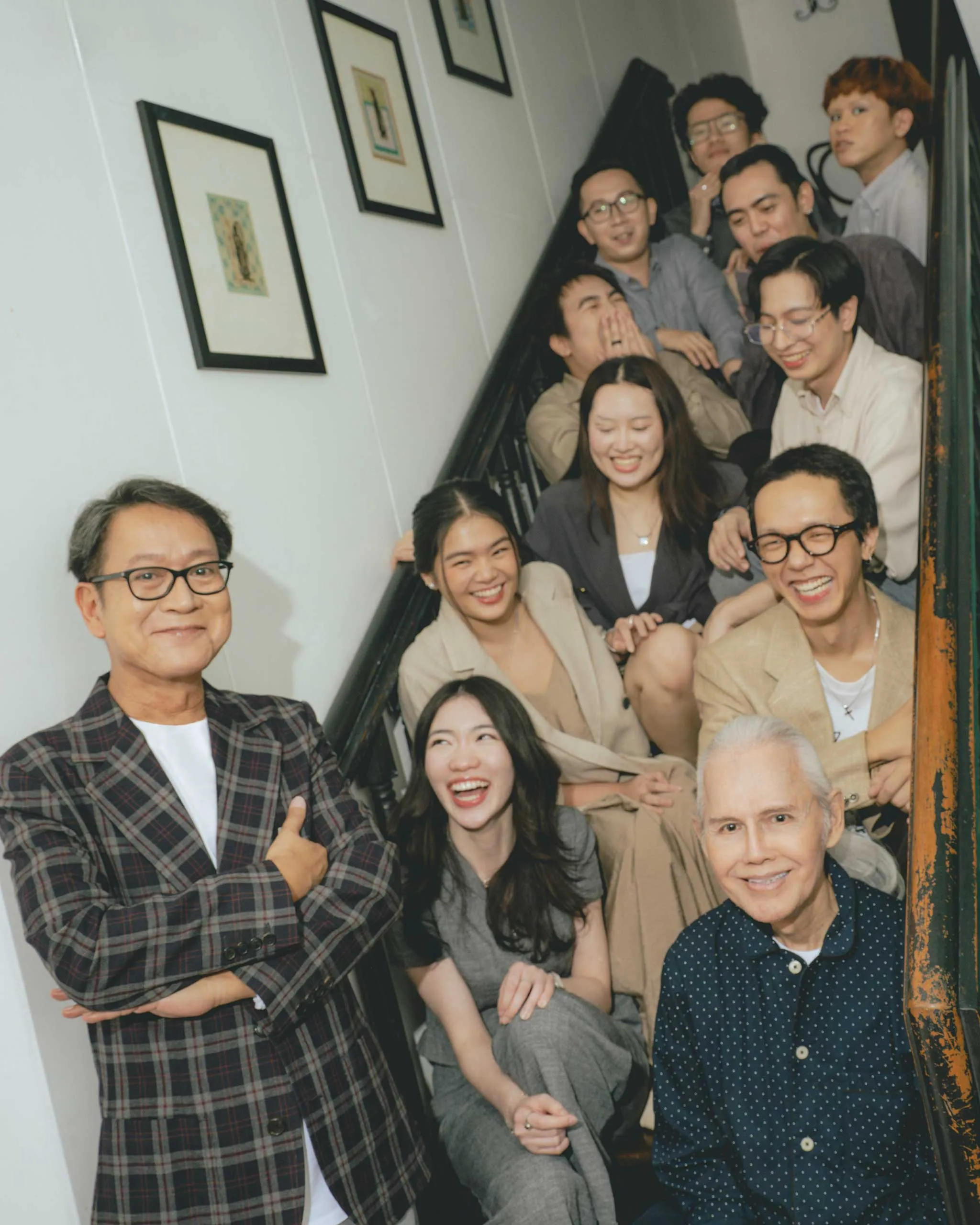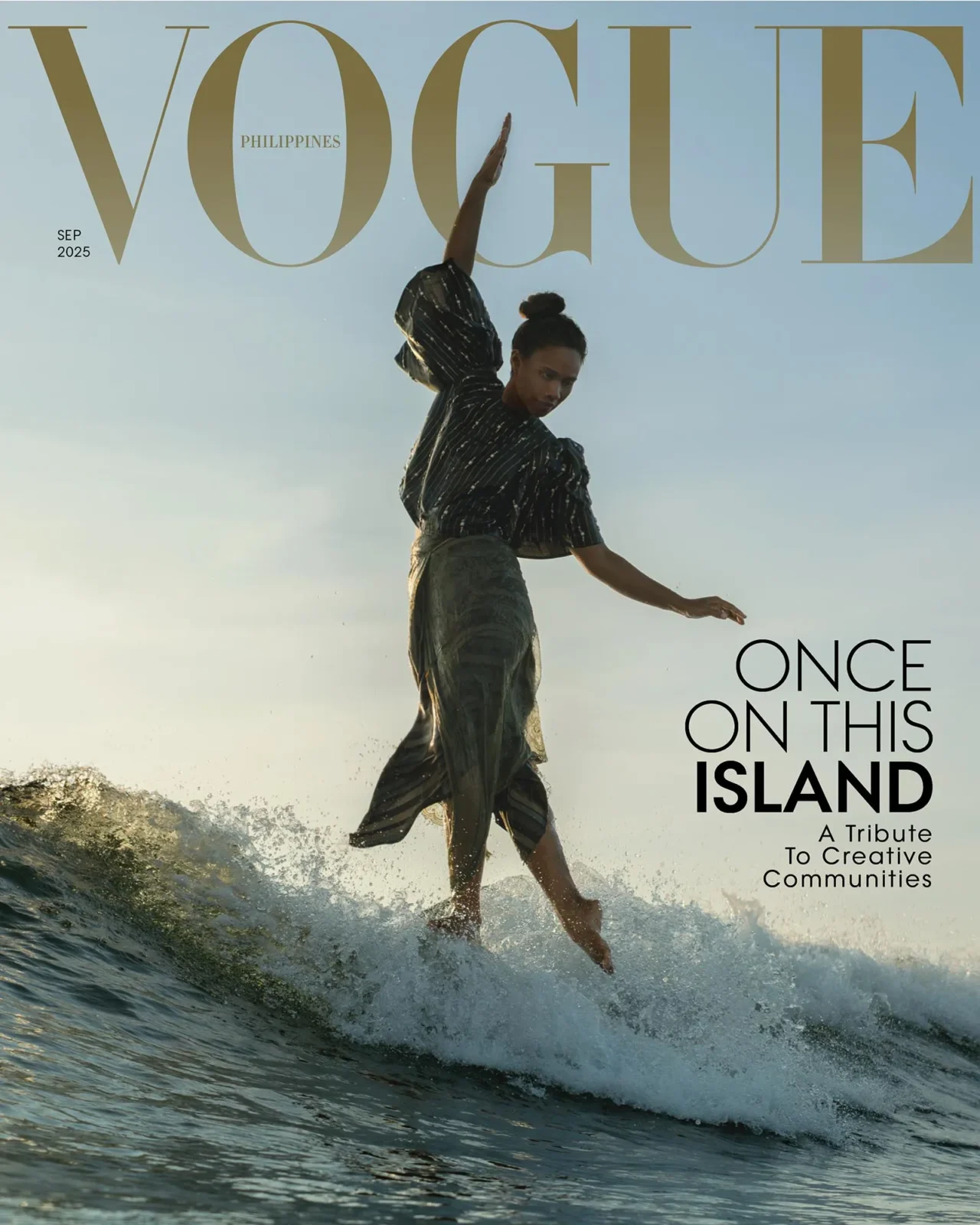Mentors Jojie and Inno, both at the foot of the stairs, share a laugh with F.A.B. students and alumni. From top left: Gian Jose, Dee Javier, Marc Carcillar, Karl Nadales, Ton Marbella, Noel Marin, Shereen Santiago, Mariko Vergara, Akio Barreiro, and Alaine Pang. Photographed by Shaira Luna for the September 2025 Issue of Vogue Philippines
How curious mentors, eager students, and a campus nestled in nature made Fashion+Arts+Business Creatives.
A mere mention of Fashion+Arts+Business (F.A.B.) Creatives begets at least one remark about their campus being beautiful. Founded in 2019, the institution is located on 2680 F.B. Harrison Street, in a gated compound along one of Pasay’s quieter inner roads. Its singular path invites a slow drive in; guests trade the metropolitan bustle for the sound of birds chirping, and the sight of towering trees and lush hedges wrapped around post-colonial homes. These structures remain vestiges of post-war Manila despite being restored anew, from the charming Henry Hotel to the mid-century and art deco furniture gallery Artelano-11.
But where, exactly, is the fashion school?
“There,” says Ton Marbella, just having climbed out of his car with a garment bag in hand. The F.A.B. graduate points to the white house at the very end of the street. “That one.”
Walking past a row of plants, the front porch comes into view. Two chairs are positioned on either side of the wide-open main door, where F.A.B.’s co-founder Jojie Lloren and Vogue’s beauty and wellness editor Joyce Oreña sit in casual conversation. In the laboratory, the legendary designer Inno Sotto lectures four students on designing a collection. In the room across, students and alumni do their makeup in preparation for the shoot. In another area, the Vogue team flips through stacks of vintage magazines on display.
The entire house, it turns out, used to be Jojie’s atelier. The studio that preceded it was located in Makati, and it was the very space where he began offering a 12-session pattern workshop in 2004. The class list of his two-week course included some of today’s most respected designers: Joey Samson, Ivarluski Aseron, Patrice Diaz, Frederick Peralta, and Len Cabili, among others.
Five years later, Jojie’s atelier moved to the Pasay compound. It was around this time that he began seriously speaking with his college friend, the visual artist, sculptor, and garment construction specialist Pidge Reyes, about a shared aspiration. “We both took clothing technology. We really wanted to put up a school, but then it didn’t push through.”
It wasn’t until 2017 that they revisited their plans. They included their college friends involved in the operations of the 100-year-old Baliuag University, namely its current president Dr. Patricia Bustos-Lagunda and her three sisters. “I asked them if they wanted to put up a school with us. That started it all. And siguro it was the right timing, because now we have a group who can really manage this school, and kami na to take care of the academics.”

All seemingly fell into place. That is, until an unimaginable hurdle sprouted out of nowhere, just when they finally got their Makati branch up and running. “After a year, or not even a year, the pandemic came,” Jojie narrates. The fact that the school still had to pay rent despite class suspensions necessitated a move elsewhere, which is how they found themselves on their current stomping grounds, on the first floor of Jojie’s atelier. He candidly reveals that enrollment is still a challenge, as high tuition fees tend to deter applicants. “Otherwise, students are happy,” he maintains. “We are happy with what we teach, and the outcome. Slowly but surely.”
F.A.B. boasts a comprehensive curriculum, covering everything from color theory to fashion history to entrepreneurship in their one-year program, and offering fashion writing, fashion show production, and more standalone workshop courses. Their faculty board is composed of industry leaders like photographer Jun de Leon and fashion show director Robby Carmona, and some design courses are handled by those who were once under Jojie’s tutelage, while others are taught by luminaries like Inno Sotto.
“It was 2019,” the latter says. “That was about the time I started.” When we greet Inno, he’s in a navy shirt and trousers, his platinum tresses tied in a neat, low ponytail that has become his signature.
After the shoot, he leads us to the laboratory where he had just conducted class, and stands before his table, immediately picking up a pencil. As his hand mindlessly continues an existing sketch on the page, the words flow out of him.
“I have this undeniable curiosity about things that are going on, and not just things related to my work, but with other people, doing other things,” he starts. Inno began teaching at the College of Saint Benilde, introducing fashion design to the school. “I liked that experience, but it’s a tri-sem school, so it wasn’t going to be easy for me to adjust my schedule,” he says. “And so I stopped there, but my curiosity continued. I was always curious about the works of younger designers, things that they’re doing, how they think. In all the classes that I’ve given, [I’ve said that] you have to draw inspiration from other things. And often, it doesn’t have to do with fabrics or things like that. And I would often point to the grill gate there,” he says, gesturing to the classroom windows, “and nobody could understand what it was I was trying to say. Sabi ko, there’s something there. You have patterns, shapes.”
This sense of designing with childlike wonder, especially as it relates to the world beyond fashion, is what he passes on to his students. TernoCon 3 finalist Dee Javier says, “Sir Inno’s class gave a different perspective on how to design sensible yet profound pieces. He would always remind us to stay curious and keep an open mind to a lot of things. Everything within reach of our senses can be an inspiration.”
Being one of the three comprising F.A.B.’s second batch of graduates, Dee cites the school as being among his best decisions. “I chose to enroll (and luckily became one of their scholars) at F.A.B. knowing all the mentors are well-known and respected creatives within the industry. It was very exciting, challenging, and intimate considering they only accept very few students.”
Compared to larger fashion schools, F.A.B.’s student body is more tightly-knit. “I want to emphasize that we have a small class size, so six students [maximum] lang per class,” Jojie says. “I like the size of the class,” Inno adds. “It’s easier for me to talk to them, to get ideas, to figure out what it is that they’re into.”
“Everything within reach of our senses can be an inspiration.”
Like Dee, F.A.B. alumnus and Mega Young Designers Competition finalist Akio Barreiro learned firsthand from the likes of Rita Nazareno and Joey Samson. When asked about his most impactful class, Akio says, “It’s impossible to choose just one! From the beginning of the program we were told to learn the rules before breaking them. We were taught all the right ways to make clothing, all the best practices. When it was time for us to turn our own designs into garments, they guided us and helped us through the process.”
Mentorship has always been the focus of F.A.B., and for Jojie and Inno, it has become even more essential now that resources are ubiquitous online. The value of in-person, on-ground training, they insist, is indispensable. Inno expounds, “I think whatever career you want to pursue, if there is a chance for anyone to have at least two years apprenticeship or training with somebody who’s actually been in the business for a while, it opens your mind. Because what they’re able to impart are the experiences they’ve had after graduating, things that probably never came to mind while they were studying.”
Echoing these sentiments, Jojie says, “The most important thing in this [school] is mentorship. The mentors have a lot of time for each student. And you know, the mentors I got are mentors who really want to share what they know.”
And that’s not to say that they know everything, because they most certainly don’t. “I mean, there would be times that I’m in class and I’d say, ‘Excuse me, I have to go to the toilet,’” Jojie confesses. “But then, you know, I grab a book, and…” he trails off, flipping imaginary pages in his palm before his shoulders shake with laughter. “I learned to be humble in terms of teaching. There were times before that I taught them something, and then the following day, ‘Um, mali ’yung tinuro ko. Okay, everybody will have pizza!’” he chuckles. “Even if you’re a teacher, you still have to study before each class, review those things you’re going to teach them.”
When he isn’t instructing, Jojie spends time mapping out the school’s expansion. He eagerly shares that soon, F.A.B. will introduce courses in bespoke tailoring and creative upcycling. They will also be moving out. F.A.B. has acquired the house right across from Jojie’s, which they’re developing with more spaces to support students and alumni; this includes a shared atelier where graduates can welcome clients and conduct fittings.
But those plans, exciting as they are, are well into the future. For now, Jojie is mostly occupied with encouraging nascent designers to commit themselves to three things: to study, study, study, and try to absorb everything. To practice a lot, because practice makes perfect. And finally, and perhaps most importantly, to dream, and to dream on.
See more of this story in the Anniversary Issue of Vogue Philippines, available at the link below.
By TICIA ALMAZAN. Photographs by SHAIRA LUNA. Deputy Editor Pam Quiñones.

